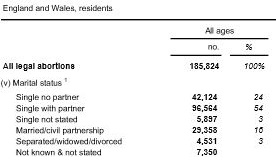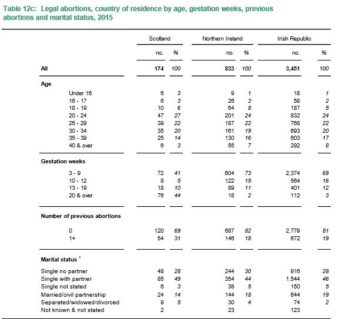Two very questionable claims were made by one of the experts invited to address the Citizens’ Assembly last month. One is that married women have an abortion rate higher than unmarried women, and the second is that countries with highly restrictive abortion laws tend to have higher abortion rates than countries with more permissive laws. This second claim is not true of the developed world.
The expert, Gilda Sedgh of the pro-choice Guttmacher Institute in New York, could only arrive at these conclusions by counting women who cohabit among married women, and by comparing apples with oranges in respect of the abortion rates in different kinds of legal regimes.
It is true that the rate of abortion in developing countries is often much higher than in the developed world. But within the developed world, it is not true to say that the rate of abortion is lower in countries with more permissive abortion regimes. Is this so, then why is the abortion rate in Sweden or Britain or France much higher than the Irish abortion rate? (I will deal with this in a follow-up blog post).
Let’s look in some detail here at Sedgh’s claim in her paper and in her presentation that married women have an abortion rate higher than the unmarried.
She said: “The estimated global abortion rate in 2010–2014 was 36 per 1,000 for married women and 25 per 1,000 for unmarried women. Married women are estimated to have higher abortion rates than unmarried women in all sub-regions except Western Africa and Northern America, where the reverse appears to be true. Globally, as of 2010–2014, a little more than one-quarter of all abortions—27% or 15 million—occurred among unmarried women.” (p. 3)
She takes her definition of ‘married’ from the UN Population Division and in her talk she does briefly outline her definition of ‘married’. As mentioned above, the definition, and therefore the figure for the number of ‘married’ women who have abortions, is highly misleading. She uses data from this recent article, which she co-authored, where married women are defined as “women in formal marriages or in non-marital cohabiting unions.” (p. 259). So, she includes cohabiting women. But being married is not the same as cohabiting. They are two distinct things and they should not be conflated. Moreover, in the written submission and the accompanying slides that can be found on the Citizens’ Assembly website there is no clarification of what she means by ‘married’.
If we want to understand the relationship between marriage and abortion it is much more accurate to consider the abortion rate in developed countries (countries with which Ireland can be more or less meaningfully compared) between married women, unmarried women with a partner, and unmarried women without a partner. The differences are significant, and they are especially huge when we compared married women, and unmarried women with partners.
For instance, the most recent document by the UK Department of Health regarding England and Wales in 2015, under the heading “Marital status“ says: “about four-fifths (81%) of abortions in 2015 were carried out for single women, a proportion that has risen slowly from 79% since 2005.” (p. 11)
Look closely at ‘single with partner’ figure. Look at how high it is. It accounts for more than half of all abortions whereas married women account for only 16pc of abortions. So, in terms of their propensity to have an abortion there is simply no comparison between married women and unmarried women with a partner. Calling both categories ‘married’ and treating them as if they are the same is extremely unhelpful, to put it very mildly. Why didn’t the organisers of the Citizens’ Assembly pick up on this?
A similar misleading claim has been made by the Coalition to Repeal the Eighth in their submission to the Citizens’ Assembly. “UK abortion statistics for 2015 show that two thirds (64%) of women from Ireland were married or in a relationship.” (p. 13). What they omit to specify is that 64% (they should have said 65%) is actually the sum of figures about married women (19%) and single with partner (46%). Again, why do they conflate two distinct figures?
Because they don’t want to admit that among those who have abortions, married women are the smallest cohort when compared with singles with a partner or with singles without a partner.
Let us consider these figures from the UK Department of Health:
Married women (or in a civil partnership) account for 19% of all Irish residents who have abortions in the UK.
It is interesting to analyse the breakdown among the singles. Singles with no partners represent a much lower percentage than those with a partner. Among the women resident in the Republic it is 28pc vs 46pc, in Northern Ireland 30pc vs 44pc, in England and Wales 24pc vs 54pc, in Scotland 28pc vs 49pc.
The figures are all very similar. It is clear that unmarried women with partners are more likely to abort than unmarried women with no partner. Why? Pressure coming from the partner? A similar pattern emerges in the US where cohabiting women have an abortion rate twice the average while married women have an abortion rate that is less than a half of the average. (see note 1 below)
The Guttmacher Institute should not have conflated married women and unmarried women with a partner and the Citizens’ Assembly should not have let them do so.
Note 1
A recent study on “Characteristics of U.S. Abortion Patients in 2014 and Changes Since 2008” states that “Relationship status can be a proxy for exposure to sexual activity, and can also influence individuals’ and couples’ childbearing goals. The distribution of abortion patients and abortion indices varied by relationship status. About 14% of abortion patients were married, and an additional 31% were cohabiting. A slight majority were not living with a partner in the month they became pregnant (46% had never married and 9% had been previously married). The 2014 abortion index of 0.4 for married patients indicates that they were substantially underrepresented among abortion patients relative to all women of reproductive age. Cohabiting women were overrepresented by a factor of 2.1, meaning they had an abortion rate twice the national average. The abortion index for never-married, non-cohabiting patients was slightly higher than average (1.2).”


















